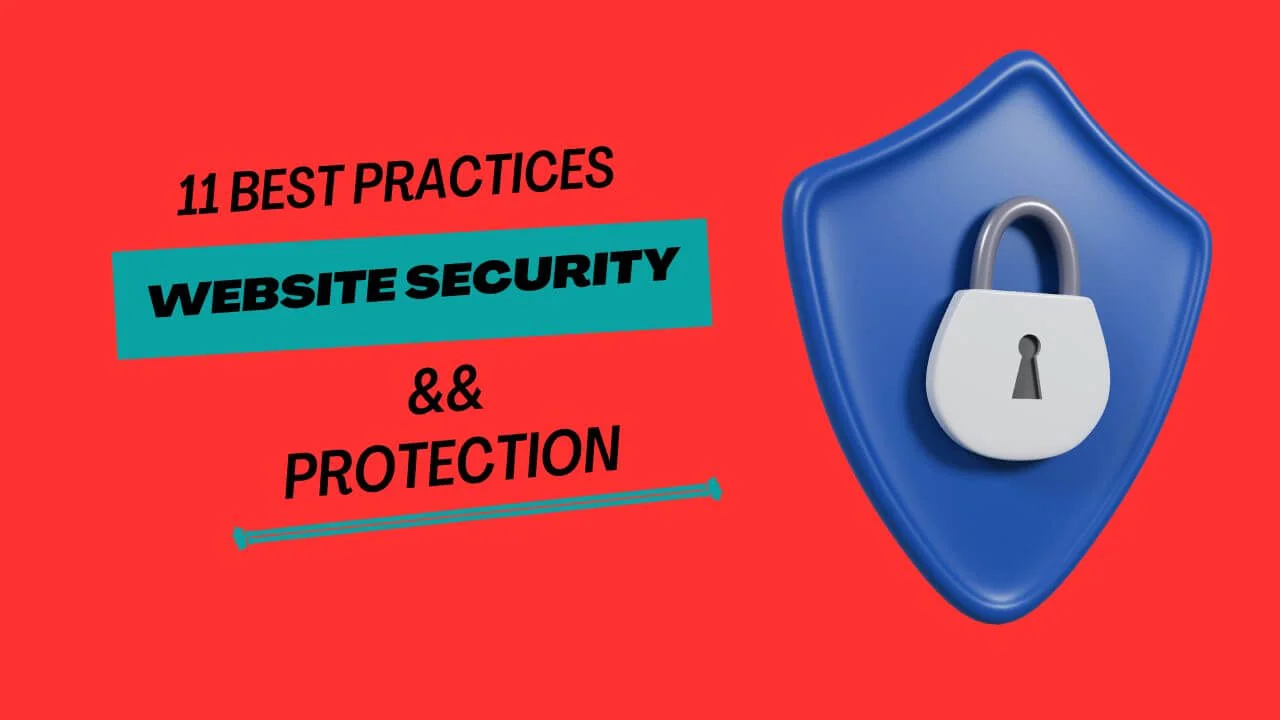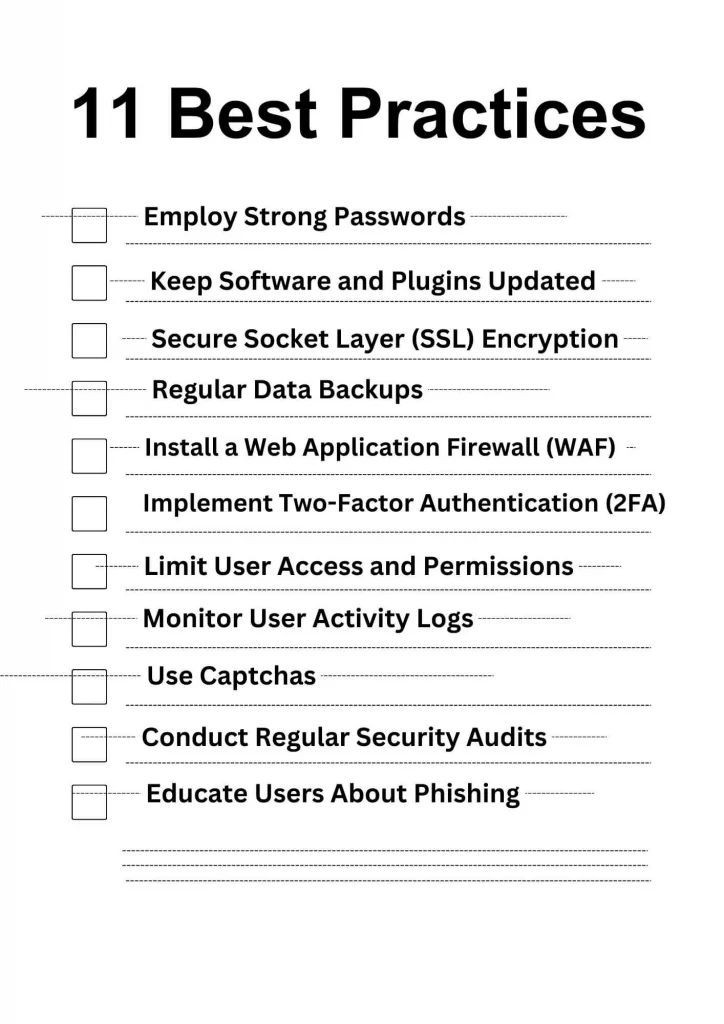11 Best Practices for Website Security and Protection (2023 Updated)
In today’s digital age, websites have become the virtual face of businesses and individuals alike. However, with the increasing reliance on the online world, cyber threats have also intensified. The query that comes to mind is how to keep your website from vulnerable threats.
To ensure your website’s safety and protect your valuable data, implementing robust security practices is crucial.
Let’s begin;
You Have To Need 11 Best Practices for Website Security and Protection
In this blog, we will explore 11 best practices for website security and protection, using simple language, and transition words to guide you through each step. We will try to mention the full details about how to safe from threats and what should we do steps.
1. Employ Strong Passwords
The foundation of website security checklist lies in using strong passwords. Avoid common passwords like;12345 or password; and opt for a combination of letters, numbers, and special characters.
Additionally, change passwords regularly to minimize the risk of unauthorized access. Using strong passwords is crucial for maintaining the security of your online accounts and personal information.
Remember that the goal of using strong passwords is to make it difficult for attackers to guess or crack them. Implementing these practices can significantly improve your online security.
2. Keep Software and Plugins Updated
Regularly update your website’s software, including the content management system (CMS) and plugins. Developers often release updates to patch security vulnerabilities, and staying up-to-date ensures you are protected against potential threats.
Keeping software and plugins updated is a crucial aspect of maintaining the security and functionality of your digital devices and applications. By following these
practices, you can reduce the chances of encountering security issues.
This ensures that your software and devices are running smoothly with the latest features and improvements.
3. Secure Socket Layer (SSL) Encryption
Implementing SSL certificates is one of the best practices for website security and protection on your website to establish a secure connection between the user browser and the server. SSL encryption safeguards data during transmission, such as login credentials and sensitive information, protecting it from interception.
Secure Socket Layer (SSL) encryption is a cryptographic protocol used to secure data transmission over the internet. Its successor, Transport Layer Security (TLS), is the more modern version of the protocol, but the term SSL is still commonly used to refer to both SSL and TLS.
4. Regular Data Backups
If you are wondering about how to secure website from hackers, then you must perform routine data backups to ensure you have a recent copy of your website’s content. This practice is vital in case of a security breach or server failure, as it allows you to restore your website to a previous, uncompromised state.
Regular data backups are an essential practice for preserving and protecting your digital information from loss, corruption, or accidental deletion.
By creating backups of your data, you ensure that you can easily recover important files and information in case of hardware failure, cyberattacks, or other unforeseen events
5. Install a Web Application Firewall (WAF)
A WAF acts as a barrier between your website and potential threats, monitoring incoming traffic and filtering out malicious requests. It offers an added layer of protection against hacking attempts and Distributed Denial of Service (DDoS) attacks.
Remember that WAF is one of the website security tools and provides one layer of security. It’s crucial to keep your server and applications updated with the latest security patches and employ other security measures like strong access controls, regular backups, and secure coding practices.
6. Implement Two-Factor Authentication (2FA)
Enable 2FA for user accounts to enhance login security. With 2FA, users must provide a second form of verification, such as a one-time code sent to their mobile device, in addition to their password.
Implementing Two-Factor Authentication (2FA) typically involves combining two different types of authentication methods to enhance security.
Remember that implementing 2FA requires careful planning and consideration of your user’s needs. While 2FA significantly enhances security, it’s essential to strike a balance between security and user experience to encourage adoption and compliance.
7. Limit User Access and Permissions
Restrict user access and permissions to essential personnel only. Assign different levels of access based on roles and responsibilities to minimize the risk of unauthorized changes to critical website components.
Website security is an ongoing process, and it requires vigilance and regular updates to stay ahead of evolving threats.
Consider working with security experts or hiring professionals to conduct security assessments and implement best practices tailored to your specific website and business needs.
8. Monitor User Activity Logs
Regularly review user activity logs to identify any suspicious behavior. Monitoring logs allows you to detect potential threats and take timely action to prevent security breaches. Monitoring user activity logs is just one part of a comprehensive website security strategy.
It should be combined with other security measures, such as strong access controls, regular software updates, and web application firewalls, to ensure a robust defense against cyber threats.
9. Use Captchas
Employ captchas on forms and login pages to distinguish between automated bots and genuine users. This simple measure can prevent brute-force attacks and minimize the risk of unauthorized access. While CAPTCHAs are helpful for preventing automated bots, they are not foolproof.
Advanced bots may still find ways to get past CAPTCHAs. So why is website security important? The attack of hackers can be a serious risk for your website. This is why implementing other security measures like rate limiting, input validation, and anomaly detection enhances your website’s protection against malicious activities.
10. Conduct Regular Security Audits
Perform periodic security audits to assess your website’s vulnerabilities and potential weak points. Identifying and resolving security issues proactively can significantly reduce the chances of a breach. Regular security audits and taking proactive steps to address any vulnerabilities.
You can enhance the protection of your website and safeguard your data and users from potential security breaches.
11. Educate Users About Phishing
Educate your website users about phishing scams and tactics used by cybercriminals. By raising awareness, you empower users to identify and avoid potential phishing attempts, protecting both their own data and your website’s reputation.
Final Thoughts
Securing your website is not an option, it’s a necessity in today’s digital landscape. By following these 11 best practices for website security and protection, you can fortify your website defenses and protect it from cyber threats.
Implement strong passwords, keep software updated, use SSL encryption, and establish routine data backups to ensure your website remains safe and your digital presence stays protected. Combine these practices with constant vigilance and user awareness to create a robust shield against potential security breaches.
FAQ’s;
How do I make my website safe and secure from any unusual activity?
- Update your site regularly
- Installing SSL Certificate
- Must use strong and unique passwords, and also must be changed after any suspicious activity.
- Scanning & using strong safe tools for security purposes
What’s the website security protection?
The main thing is to measure to secure a website from cyberattacks, which may include malware errors, scams, and many more.




